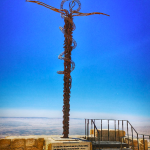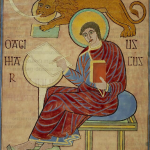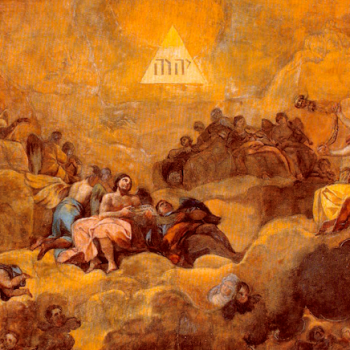“Lullay, Thou Little Tiny Child”
Ag Críost an síol, ag Críost an fómhar,
in iothlainn Dé go dtugtar sinn.
Ag Críost an mhuir, ag Críost an t-iasc,
i líonta Dé go gcastar sinn.
Ó fhás go h-aois, is ó aois go bás,
do dhá láimh, a Chríost, anall tharainn.
Ó bhás go críoch, ni críoch ach athfhás,
i bParthas na ngrás go rabhaimid.
Christ’s is the seed, the harvest Christ’s;
into God’s barn may we be brought.
Christ’s is the sea and Christ’s the fish;
within God’s net may we be caught.
From birth to age, from age to death,
Thy two hands, Christ, about us be.
From death and end—no end, new life—
Take us to Paradise with thee.
The origins of the above poem are uncertain. I encountered it first in an album of lullabies titled The Planet Sleeps, and I’ve been using it for that purpose with the baby of a married couple I know, whom I’ve been helping with for a few months. My family has always had eclectic tastes, and The Planet Sleeps certainly plays to that. Besides Ag Críost an Síol (pronounced, roughly, ak chree-ust ahn sheel), it features another Celtic lullaby (in Scots Gaelic), an Iroquois tune, one in Japanese, one from Cambodia, one sung by a Bosniak choir, a Hebrew lullaby, one by a musician from northern India that he wrote for his daughter—it’s kinda great!
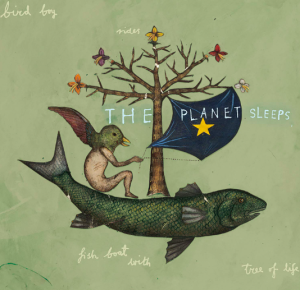
Image provided for under fair use.
My family have Irish on both sides: the Brown family (natives of Galway, in the west) on my mother’s, and on my father’s, we are descended from the O’Sheas, who hail from the extreme southwest of the island. If there’s any truth to this sort of thing, which there’s not, I have the ghosts of Ireland in my blood; it feels natural to me that I’d connect with this song.
And talking of ghosts. According to folklore, one of the many fae beings that populate Ireland is the banshee.* I had vaguely assumed the basics of banshee lore were common knowledge, but when I mentioned them in passing at a family gathering once, no one seemed to know what I was talking about (what my sisters can possibly be homeschooling those boys about, I have no idea). For those who may need to know: the Good Folk** don’t exist, and here’s the short version of this particular species.
The banshee usually takes the form of a young woman (crones are also reported). Young or old, they are usually quite small, like most members of the Good Folk—perhaps four feet tall at most. They’re best known for their cry, called keening. It is named after what used to be an Irish, and to some extent Scottish, funeral custom, or rather is a specimen of that custom: a female relative of the deceased would sing (unaccompanied) a shrill song of lament, always in the region’s Gaelic dialect. Banshees do the same. They are supposed to be tied to families; they keen just after, or even before, the death of a member of the clan they are attached to, sometimes as a warning.
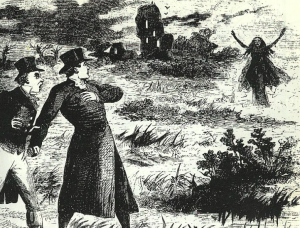
The Banshee Appears, drawn by R. Prowse, 1862.
Traditionally, the only people attended by banshees are the true Goidelic† families, whose surnames begin with Ó or Mac: folk whose ancestry is Norse (venial), Norman (grave), or Anglo-Saxon (unpardonable), are “right out.” In theory, this should make me and my sisters eligible, as descendants of the O’Shea clan: it should also make us ineligible, given our substantial English ancestry. However, there is nothing at which the Irish are more practiced than charming hypocrisy—Catholics to the core—and banshees have been reported for those with Norman and even Saxon blood, if the Irish like them well enough. (The FitzGerald family in particular, who came over with Henry II in the twelfth century and became “more Irish than the Irish,” are supposed to have a banshee.) I therefore cherish the idea that, our blandly south-of-England surname notwithstanding, there is a sprite who will keen for us at our passing.
At this point, the reader may pardonably be wondering what on earth any of this could possibly have to do with the Gospel According to St. John. The answer is, nothing, and I have dragged it in by the heels. However, I did so because I was struck by a couple of coincidences between the lullaby and the Gospel below: one, the link between “the seed of Christ” in the poem and the metaphor used in this passage; and two, Christ yet again foretelling his death and being saluted by a supernatural voice, which suggest the image and function of the banshee.
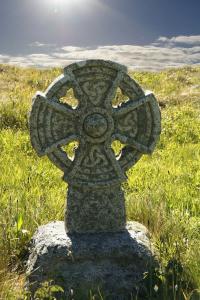
John 12.20-33, RSV-CE
Now among those who went up to worship at the feast were some Greeks.a So these came to Philip, who was from Bethsaida in Galilee, and said to him, “Sir,b we wish to see Jesus.” Philip went and told Andrewc; Andrew went with Philip and they told Jesus. And Jesus answered them, “The hourd has come for the Son of man to be glorified.e Truly, truly, I say to you,f unless a grain of wheatg falls into the earth and dies, ith remains alone; but if it dies, it bears much fruit. He who loves his lifei loses it, and he who hates his life in this world will keep it for eternal life. If any one serves me, he must follow mej; and where I am, there shall my servant be also; if any one serves me, the Father will honor him.
“Now is my souli troubled. And what shall I say? ‘Father, save me from this hour’? No, for this purpose I have come to this hour. Father, glorifye thy name.” Then a voice came from heaven, “I have glorified it, and I will glorify it again.”k The crowd standing by heard it and said that it had thundered. Others said, “An angel has spoken to him.” Jesus answered, “This voice has come for your sake, not for mine. Now is the judgmentl of this world, now shall the rulerm of this world be cast out; and I, when I am lifted upn from the earth, will draw all men to myself.” He said this to showo by what death he was to die.
John 12.20-33, my translation
There were some Greeksa among those who came up in order to worship at the feast; then these came forward to Philip from Bethsaida in the Galilee, and asked him, saying, “Lord,b we want to see Jesus.” Philip came and spoke to Andrewc; and Andrew and Philip came and spoke to Jesus. Jesus replied to them, saying, “The hourd has come, in order that the Son of Man be glorified.e Amen! amen! I tell youf: unless an acorn of grain,g falling into the earth, dies, ith stays alone; yet if it dies, it bears much fruit. He who loves his lifei destroys it, and he who hates his life in this world guards it into life world-without-end. If someone serves me—follow mej; and where I am, there also my servant is; if someone serves me, the Father will honor him.
Now my lifei is troubled, and what shall I say? Father, save me from this hour. But I came for the sake of this hour. Father, glorifye your name.” Then there came a voice out of heaven: “I have both glorified it and will glorify it further.”k Then the mob standing there and listening said there had been thunder; others said: “A messenger talked to him.” Jesus replied and said: “This sound did not come for me but for you. Now there is judgmentl of this world, now the princem of this world will be cast out of it; and I, if I be liftedn from the earth, will draw everyone to myself.” This he said signifyingo what kind of death he was about to die.

Textual Notes
a. Greeks: In the New Testament, this word most often means people of the Greek ethnicity; however, it was sometimes used as a synecdoche for Gentiles in general. (It may also have been used for Hellenists, Greek-speaking Jews who had settled in other parts of the Mediterranean, but I gather these were more normally referred to by, well, the word “Hellenist”!) In this case, it may refer to theosebeis [θεοσεβεῖς] or “God-fearers,” Græco-Roman sympathizers with Judaism who worshiped the Judaic God and participated in Judaic custom and ritual to a point, but stopped short of full conversion through circumcision.
b. Sir/Lord: English has quite a large vocabulary and freely adopts words from other languages. On the whole, since this allows very precise use of language for those who want it without imposing it on those who don’t, these are positive traits. However, they do come with drawbacks. One such drawback is that, though many languages have a single title that expresses both “lord” and “sir,” English doesn’t.
c. Andrew: The role played by St. Andrew here is clear enough: he is helping St. Philip tell Jesus about the Greeks who want to see him. Why Andrew is playing this role, as opposed to Philip just talking to Jesus on his own initative (they do know each other reasonably well at this point), is less clear. He and Philip are the only two apostles who have Greek first names; Andrew means “manly, courageous,” which might invite allegorization, but Philip means “lover of horses,” so if there’s an allegorical layer here I’m assuming the names aren’t the key to it.
d. hour: The Greek hōra [ὥρα], a frequent term in the Gospel of John, is a little more flexible than the English “hour,” for two reasons. One is that it can be used loosely as a synonym for “time (for some event or purpose)”; this usage does exist in English, but trends toward the poetic. The other is that in the ancient world, “relative hours” were sometimes used: i.e., rather than all hours consisting in the same measurement of sixty minutes, an hour could be understood as simply “one-twelfth of a night or a day,” meaning that summer days literally would have longer hours and winter shorter ones.
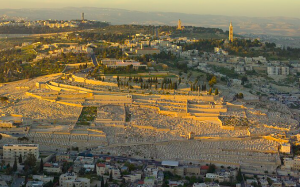
An ærial view of Mount Olivet from the
south in the evening. Taken by Andrew
Shiva in 2013; used under a CC BY-SA
4.0 license (source).
Jesus speaks of “his hour” several times in John: notably, his reason for originally demurring when the Virgin tells him in chapter 2 that “They have no wine” (and that whole interaction is a mystery unto itself) is that his “hour has not yet come.” Luke, too, includes a very Johannine-sounding remark, made during his arrest (in 22.53): “This is your hour, and the power of darkness.”
In particular, Jesus states that his hour “has come” both here and in chapter 17, a passage generally known as “the high-priestly prayer,” which concludes the Upper Room Discourse (John 13-17) and is considered to be in some sense the sacrificial dedication said by Jesus over his self-offering to the Father. Both passages dwell on the theme of glory, and it can be said that the Johannine perspective on the Crucifixion is very much one of glorification—that the “lifting up” on the cross is only the first phase of a “lifting up” of Christ in a spiritual or cosmic sense. I can’t at present recall where I read this, might’ve been Raymond Brown, but I read in some commentator that for John, the Crucifixion, Resurrection, and Ascension are in essence a single act—”the Exaltation,” as we might call it.
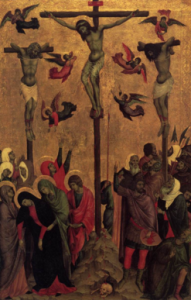
e. glorified | glorify: Glory, in Greek doxa [δόξα], is another of those key concepts in John (and indeed, the Bible generally). The Greek is related to the verb dokeō [δοκέω], “to appear, seem.” This verb is a little paradoxical. It carries both the sense of “it seems such-and-such a way but it’s not” (as in Docetism), and the sense of “it seems that way because it is.” Doxa originally meant “opinion, judgment, belief”; it leaned toward the affirmative sense of the verb. It is through that line of meaning that the word orthodoxy got its meaning: orthodoxy is doxa that is orthē [ὀρθή] (“straight, upright; correct, true, authentic”).
A slightly different inflection of doxa led it to mean “reputation,” and thence “honor, fame,” and ultimately “glory.” This sense did already exist in the New Testament, and in fact had for centuries at that point: the translators of the Septuagint, then almost three hundred years old, used doxa to render the Hebrew kavod/kabhowdh [כָּבוֹד].‡ This word is nearly always translated “glory,” and comes from the same root at the word for “heavy,” a little reminiscent of the Roman virtue of gravitas.
When we think of the idea of glory today, I for one have usually had a vague mental picture of a luminous, hazy cloud, surrounding whatever thing “has” the glory in question (which pretty much invariably means God). While perhaps childish, I don’t think this picture-thinking is groundless; most of the early mentions of God’s glory in the Torah do precisely involve both the Pillar of Cloud and bright light, a blend of illumination and obscurity—a blend aptly symbolized by the veil Moses wore, not to speak to God, but to speak to the Israelites after speaking to God.
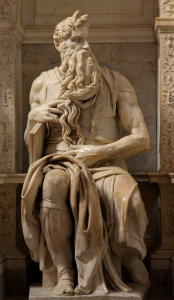
Moses, by Michelangelo, 1513-1515. Photo
by Jörg Bittner Unna, taken in 2011, used
under a CC BY 3.0 license (source). The
horns are … complicated.
Accordingly, it is hardly surprising that the doxa (glorification) of the Son by the Father should nonetheless involve uncertainty and confusion among those present—a theme also touched on near the beginning of Lent, at the Transfiguration—and thereby to a diversity in the doxa (beliefs) held about him by various people. The example of the heavenly voice here accents this theme yet again, pointing us, as John so often does, to the task that is set for the reader or listener by his Gospel: What then will you do with Jesus who is called Christ?
f. Truly, truly, I say to you/Amen! amen! I tell you: Amen is one of the many religious words that English inherits ultimately from Hebrew (and one of the ones that changed the least on its way here via Greek and Latin). Its use here, in a favorite formula of Jesus, is striking. Then as now, ‘amen [אָמֵן] was used principally as an expression of assent or agreement at the close of a reading from Scripture or a prayer. To begin a sentence by saying “amen” would have been rather like beginning a sentence with the word “Truth!”, and then proceeding with what you had to say, as if after a colon. The translations that turn amen, amen into “truly, truly” are thus correct in substance. (I have kept it because the word is after all Hebrew, not Greek.)
g. grain of wheat/acorn of grain: This phrase is a little odd. The word I’ve translated “acorn” is kokkos [κόκκος], which I can’t help but think may be an onomatopoeia of sorts; you can imagine an acorn falling to the ground with a little chokk sort of sound. “Corn” or “seed” would also be credible translations; I settled on acorn because kokkos was also the name of a type of an evergreen tree or shrub from the oak genus, the Quercus coccifera or Kermes oak (the seeds of which are indeed—what’s the word for this? “acornic”?).

Quercus coccifera acorns and holly-like
leaves. Photographed in 2006; used
under a CC BY-SA 3.0 license (source).
The other word here is sitos [σῖτος], which often does mean wheat specifically, but can refer to cereal crops in general. The sense of the two words together is most likely “grain of wheat.”
h. it: This sentence stands out, mostly because the phrase “it remains alone” or “it stays alone” has an explicitly stated pronoun. This wasn’t needed in the Greek (as it’s a much more fully inflected language than English), but John sticks in an autos [αὐτὸς] nevertheless. This gives it an almost anthropomorphic sound, as if it were calling the seed “he” instead of “it.”
John may do the same thing earlier on, in 8.44, and I’m sorry, I know this post is already long but we have to make this detour. That verse is normally translated with the phrase “he,” i.e. the devil, “is a liar and the father of lies.” However, and this is one of the things I learned in my independent study of John, a hyper-literal translation would not use “lies,” because that word does not appear. Translators insert it as a translation of the genitive form of autos—the genitive is the “of” form of a word—taking it to mean “he is a liar and the father of it [i.e. of lying-as-a-thing].”
Yet my professor (a fellow Catholic) was as surprised as I was to see this text behind the familiar verse; she confirmed it would be a very un-Greek construction, if the text did mean that. A more natural reading of the Greek would be “he is a liar and the father of him [is one too],” or “he is a liar and so is his father.” This makes my mind jump to the anti-trinity of Revelation 12-14: the Dragon, the Beast, and the False Prophet. We are used to associating “the devil” with the Dragon, and with good reason: that ancient serpent, called the devil or Satan, etc. If, however, “the devil” in John 8 were referring instead to the Beast, then this natural reading of the Greek of John 8 might be plausible: “he is a liar and so is his father” would denote the Beast and his father the Dragon. This would imply, probably, a grander or more cosmic function for the Beast than I’ve usually heard proposed. But again, all this is quite speculative: autos can mean “it”; I haven’t found commentators who endorse, or even translators who propose, this alternate rendering; and I’m not entirely sure what the implications would be, even if it were true.
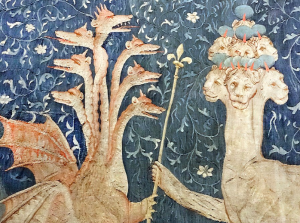
The Dragon conferring his authority on
the Beast (panel of a fourteenth-century
French tapestry). Photographed by
Jean-Pierre Dalbéra in 2012 (source).
i. life … soul/life … life: The words that normally mean “life” are bios [βίος] and zōē [ζωή]; here, however, the word is psüchē [ψυχή], which can (often more usefully) be translated “soul.” Like pneuma [πνεῦμα] and the Latin words anima and spiritus, it originally referred to wind or breath.
j. If any one serves me, he must follow me/If someone serves me—follow me: This is grammatically intriguing, because it contains something that English does not possess: a third-person imperative. Our equivalent in English is what’s sometimes called a jussive (named from the Latin jubēre, “to command, order”): “Let them [do or endure a thing]” is the formula, as in Let them eat cake or Let them be anathema (and on similar lines, the commonplace “Let me see” is thus analogous to a first-person imperative). The Lord’s Prayer also features third person imperatives: the phrases thy kingdom come and thy will be done are in the imperative mood, with God’s kingdom and his will as their subjects.
k. again/further: Here we have a debatable difference in translation. “Again,” or “re-,” can take a few forms in Greek; probably the commonest is the preposition ana [ἀνά], which can be repurposed as a prefix, ana- or an-. (Independently it means “up” or “back”; in John 3, Jesus tells Nicodemus that to enter the kingdom, one must be born anōthen [ἄνωθεν], “from the top”: he means from above, but Nicodemus takes it in the sense from the start—which may possibly indicate that this conversation was originally conducted in Greek: “Nicodemus” is a Greek name, and it was a current language among Jews as well as Gentiles, even in Palestine, so it might have been his native tongue.) However, ana isn’t the word used here; what the text has is palin [πάλιν]. This can mean “again” or “anew,” but can also mean something like “further,” “doubly”—the atmosphere is almost all that and then some. (Intriguingly, when the New Testament speaks of “regeneration,” the standard term is not anagenesia [ἀναγενεσία] as we might expect, but palingenesia [παλιγγενεσία].)
l. Now is the judgment/Now there is judgment: This one, I’d be particularly will to accept correction on if I’ve made an error, because I’m not positive I remember all the rules about handling the absence of an article correctly. But, taken literally, the Greek doesn’t say “now is the judgment”: it just says “now is judgment,” seeming to imply that this is a judgment against “the prince of this world,” one of multiple—a key one, doubtless, but probably not the final one. This would align this passage to some extent with Luke 10:18, where Jesus tells the Apostles “I saw Satan fall like lightning from heaven,” in reference to the mission of the Twelve. This mission doesn’t seem like it would be all that significant a defeat for Satan, compared with something like the Incarnation or Pentecost or the Resurrection—though of course, that could be just due to human blinders being on; maybe that mission was far more cosmically important than it looks. But it could mean that Satan’s “fall from heaven,” or “judgment,” what have you, took place in multiple senses at discrete times—perhaps that his “access” to heaven had different aspects which were not all revoked at once.
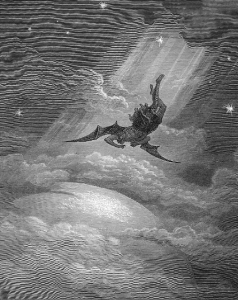
The Fall of Lucifer. Line drawing by
Gustave Doré, created in 1866 as an
illustration for Paradise Lost.
In fact, we know this was at least kind of true in at least one way. To fall morally is clearly to lose “heaven” in the sense of perfect union with God and delight in his presence. Yet it is apparently long after this that Satan is cast down by St. Michael, after the heavenly war in Revelation 12, and judging from both that passage and the first two chapters of Job, he was fulfilling his function as the “heavenly prosecutor” during that intervening time. Exactly what that means for this passage?—really can’t say. However, picking up on something I observed a week ago (see note e in this post) that may or may not be relevant, I do observe that the language here is that of exorcism, of “casting out.”
m. ruler/prince: Here we have one of my problem-words, archōn [ἄρχων]. It is a problem-word, because it’s related to archē [ἀρχή], a severe problem word. See, archē means “beginning” or “origin” (in the temporal sense), and that’s fine; it can also mean “source, principle” (in the derivation-of-being sense), no issue there; it can also also mean “end” or “edge” (as of a stick or a piece of paper)—fine; and then, it can also also also mean “dominion, power, rule, sovereignty” (in either the effective or the de jure sense). This is less fine. I can’t think of an English word that embraces all of those meanings! And it disobligingly passes this complex of meanings on to its derivatives and indirect relatives, such as archōn. I went with “prince” on the grounds that it is, barely, related to words like “principle” that carry something of the meaning of archē.
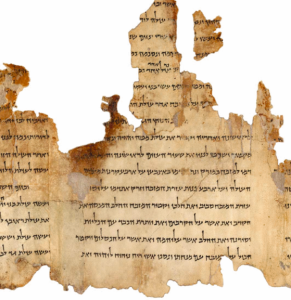
n. when I am lifted up/if I be lifted: I have the impression (from this passage and John 3, both of which use the phrase, and in this one at least the crowds seem to grasp that he is talking about being killed on a cross) that this was an idiom, referring to crucifixion; however, I don’t have a commentary at my elbow, so I’m not positive. Given the other things “lifted up” can mean, this theory might sound weird, but it’s not especially. When we say that a criminal was “hanged,” the context makes it obvious it’s an execution, but this doesn’t then get us confused when we say shortly thereafter that we’re “free to hang” or that we need to “hang a picture.”
o. to show/signifying: Here we have a noteworthy verb, sēmainō [σημαίνω]. As touched on before, the Fourth Gospel gives a rather unusual role to miracles, relative to the Synoptics; moreover, while all four refer to Jesus’ miracles as sēmeia [σημεῖα], “signs,” John does so the most consistently, and even seems to avoid using other words for them (such as thaumates [θαύματες], “wonders”). As so often, the accent is on the fact that these things are evidence; even in John, Jesus is recorded as being skeptical about the faith that seeks no more than a sign (as in 4.48 or in 6.26), but it is only in John that he accents the fact the miracles are evidence; it is, after all, a crying absurdity of human nature, not a peculiar quality of faith, that makes it hard for us to believe in the unfamiliar even when it is in front of us. (This, incidentally, is why—without comment on the other films of the franchise, which, like banshees, do not exist—”The Santa Clause” is a great movie. It doesn’t just have something to say about faith that’s true and important, but about refusal to believe as well.)
Anyway, the fact that Jesus is now not only saying, but “signifiying” in words, that he is about to die, could be taken a few ways. By aligning it with the miracles, it may be reiterating Jesus’ role in the drama as the defendant of the book, a theme that will be more explicitly resumed in vv. 47ff. of this same chapter. There is another possibility, based on the words John didn’t use here. By describing Jesus as “signifying” how he was about to die instead of merely “saying” it—and the standard verb “to say,” legō [λέγω], is the one that’s related to the all-important Logos, the one that “was with God and was God” back in chapter 1—he may make Jesus’ statement slightly more remote; it is a sign of what will come, but we usually call things “signs” instead of “words” when they aren’t words, or are words we don’t understand. Although Jesus is being clear, he is cryptic to his audience, who will not hear—also a motif picked up in the later verses of this same chapter, and tying into the motif of light and darkness that has recurred repeatedly throughout but especially since chapter 9 and the healing of the man born blind.

*This word is borrowed directly from Irish—bean sí in the modern spelling, ben síde in Old Irish (and if there is any language in the world whose spelling is more impossibly wretched than that of modern English, it is Old Irish, whose orthographers shall not see the light of heaven). Sí, síde, or sidhe—all spellings are pronounced shee—is the name for the curious circular mounds that dot the Irish landscape. Their construction is widely attributed to the Good Folk,** and a bean sí is literally a “woman of the mound.”
**Do not take this euphemism literally. Even the most benign fae beings are not safe or trustworthy, and do not exist.
†The Celtic peoples of the British Isles are divided into two branches. One is the Goidels, or Gaels (the later form), who are subdivided into the Irish, Manx, and Scots. The other branch is the Brythonic, or Brittonic, peoples and their languages: the Bretons, Cornish, and Welsh, who come from Brittany, Cornwall, and Wales—the Bretons migrated to Brittany from the Isles in Late Antiquity and the Early Middle Ages, and were originally one group with the Cornish. The two branches also lent their names to the Goidelic and Brythonic languages: Irish, Manx, and Scots Gaelic form the Goidelic branch, while Breton, Cornish, and Welsh are Brythonic. Welsh is a thriving tongue; Irish, Scots Gaelic, and Breton have all hung on (the third by a thread); Manx and Cornish did go extinct, but are seeing revival efforts. Finally, just to make it all a tiny bit worse, the word Goidel was actually a loan taken by the Irish from Welsh.
‡Can I just say, I’ve never been altogether satisfied with any system I’ve found or come up with for transliterating Hebrew. When you want to be as one-to-one as you can, but also readable, there seems to be no good course for how to represent the matres lectionis.


